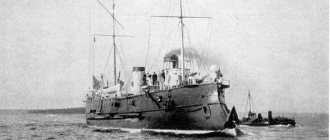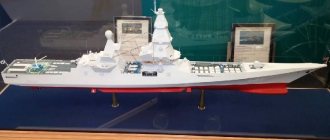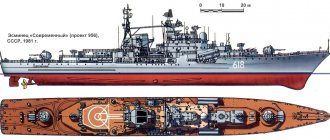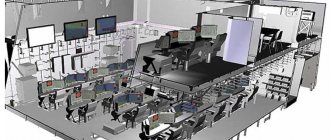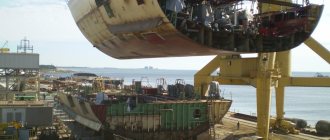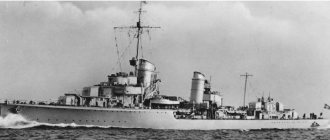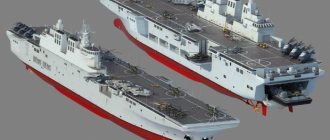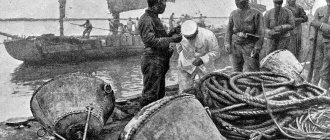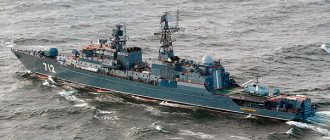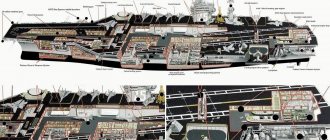| This article includes a list of common references, but it remains largely unverified because It lacks a sufficient number of relevant embedded links . |
1940s US Navy destroyers
Fletcher-class destroyer
| USS Fletcher (DD-445) in original layout, 1942 | |
| Class Overview | |
| Name: | Fletcher -class destroyer |
| Builders: |
|
| Operators: |
|
| Preceded by: | Gleaves class |
| Successor: | Allen M. Sumner Class |
| Subclasses: | Ariake class |
| Expenses: | $6 million |
| Built: | March 3, 1941 - February 22, 1945 |
| On the commission: | June 4, 1942 to 1971 (USN), 2001 (Mexico) |
| Completed: | 175 |
| Canceled: | 13 |
| Lost: | 19, plus 6 not repaired [1] |
| Saved: |
|
| General characteristics | |
| Type: | Destroyer |
| Bias: |
|
| Length: | 376.5 ft (114.8 m) |
| Ray: | 39.5 ft (12.0 m) |
| Project: | 17.5 ft (5.3 m) |
| Movement: | 60,000 hp (45 MW); 4 oil boilers; 2 geared steam turbines; 2 screws |
| Speed: | 36.5 kn (67.6 km/h; 42.0 mph) |
| Classify: |
|
| Addition: | 329 officers and soldiers |
| Weapons: | Various; see section "Armament" |
Fletcher
The class
was a class of destroyers built by the United States during World War II.
The class was developed in 1939 as a result of dissatisfaction with the earlier destroyer leader types of the Porter and Somers classes. Some continued to serve during the Korean War and the Vietnam War. [3] Between 1942 and 1944, the US Navy ordered 175 Fletcher-class destroyers.
, more than any other class of destroyer, and the design was generally considered highly successful.
Fletcher
s had a design speed of 38 knots and a main armament of five 5-inch guns in single mounts with ten 21-inch torpedoes in two five-dimensional center mounts.
[4] Allen M. Sumner and the gear classes were Fletcher
derivatives.
Fletcher -class long-range ships
carried out all the tasks of the destroyer - from anti-submarine and anti-aircraft warfare to surface operations.
[5] They could cover the vast distances required for naval operations in the Pacific and served almost exclusively in the Pacific Theater during World War II, during which they were responsible for the sinking of 29 Imperial Japanese Navy submarines. [6] [ failed verification
] As a result of enormous effort,
Fletcher boats
were built in shipyards in the United States, and after the end of World War II, 11 were sold to the countries against which they were designed: Italy, Germany and Japan, as well as other countries where they had even longer and more distinguished careers. Three of them are preserved as museum ships in the United States and one in Greece.
CONTENT
- 1 Description
- 2 Design
- 3 Armament
- 4 Service 4.1 Korean War
- 5.1 Argentina
- 6.1 Surviving ships
Description[edit]
Fletcher class
(named for Admiral Frank F. Fletcher, a Medal of Honor recipient and recipient of two Distinguished Service Crosses) was the largest destroyer class ordered. He was also one of the most successful and popular among their crews. Compared to earlier classes built for the Navy, Fletchers had a significant increase in lethal firepower, including anti-aircraft guns and increased armor; this contributed to greater displacement and an increase in overall weight and height. Their flat deck design added strength to the structure; however, this made them cramped as there was less crew space below deck compared to a raised forecastle.
"Bismarck"
Bismarck-class battleships were 250 m long and 36 m wide, which made them superior to their European counterparts. At the bow and stern, 8 guns were placed, a device traditional for that time, but the accuracy of firing with shells that were light in weight and power was improved.
The Bismarck's armor was not ordinary; the hull was 70% armored. This was more than competitors. The armored area made the ship invulnerable to British salvos for a long time. The power plant could reach speeds of up to 30 knots, but was considered unreliable and uneconomical.
In 1941, the Bismarck took part in the most famous naval battle of the Second World War, in which the German detachment was opposed by English ships. Despite the fact that the battleship managed to sink the British flagship cruiser, the British planes disabled the steering, immobilizing the ship. After the next attack, realizing that the battle was lost, the crew deliberately sank the ship.
Design[edit]
Technical drawing of a Fletcher
.
Running Fletcher
and
Radford
, May 3, 1942
Fletcher class
was the first generation of destroyers developed after a series of naval treaties that had hitherto limited ship designs.
The expansion of the design was partly a response to the challenge that had plagued US Navy designs in long-range operations in the Pacific Ocean. They were also required to carry at least five 5-inch (127 mm) guns and ten deck-mounted torpedo tubes along the centerline, allowing them to match any foreign design equally. Compared to previous designs, the Fletchers
were large, allowing them to adapt to evolving defense priorities by adding two 40 mm quadruple Bofors anti-aircraft gun positions, as well as six 20 mm Oerlikon dual anti-aircraft gun positions.
This addition to the anti-aircraft missile system required the removal of the forward five-dimensional torpedo launcher, which was included in the
April 4, 1945 kamikaze [7]
Fletcher
were much less heavy than previous classes, allowing them to take additional equipment and weapons without major modifications.
They were fortunate to catch American production at the right moment, becoming a destroyer "design" followed only by derivatives of the Fletcher
, the Sumner and Goering classes. [6]
The first design input was made in the fall of 1939 from questionnaires sent to design bureaus and the Office of the Chief of Naval Operations. The design parameters corresponded to the desired armament of the next destroyer. So the question was how many guns, torpedoes and depth charges were considered desirable. It was also asked at what point the structure would become large enough to become a torpedo target instead of a torpedo delivery system. [8] The response received was that five 5-inch (127 mm) dual-purpose guns, twelve torpedoes and twenty-eight depth charges would be ideal, while a return to the 1,500-ton designs of the past was seen as undesirable. Speed requirements varied from 35 to 38 knots (40 to 44 mph; 65 to 70 km/h), and shortcomings in the earlier Sims class, which were heavy and needed lead ballast to correct this fault, forced Fletcher's design
extend the beams by 18 inches (46 cm). [9] As with other previous enclosed-deck American destroyer designs, performance suffered. This was mitigated by the deployment in the Pacific Ocean, which was relatively calm compared to the Atlantic. [10]
To achieve 38 knots (44 mph; 70 km/h) with a 500 ton increase in displacement, shaft horsepower was increased from 50,000 to 60,000 over the previous Benson and Gleaves classes. In Fletcher models
air shell boilers were used producing steam at 600 psi (4,100 kPa) and 850 °F (450 °C), with two 350 kW steam turbine driven electric generators and a 100 kW emergency diesel generator. [11] Typically Babcock & Wilcox boilers and General Electric geared steam turbines. were equipped, although other designs and manufacturers were probably used to maximize production speed.
Destroyers and torpedo boats | USSR
Leader of the destroyers "Moscow"
Leader of the destroyers "Leningrad"
Leader of the destroyers "Kharkov"
The series of destroyer leaders of the “Project 1” type consisted of 3 units - “Leningrad”, “Moscow” and “Kharkov”. "Leningrad" was built at the Leningrad shipyard No. 190 and accepted into service with the Baltic Fleet in 1936. "Moscow" and "Kharkov" were built at the Nikolaev shipyard No. 198 and in 1938 included in the Black Sea Fleet. The destroyers "Moscow" and "Kharkov" were lost in 1941 and 1943. respectively. Leningrad was sunk in 1958 after being shot as a target. Performance characteristics of the ship: standard displacement - 2 thousand tons, full displacement - 2.6 thousand tons; length – 122 m, width – 11.7 m; draft – 4.2 m; speed – 40 knots; power plants - 2 steam turbine units and 3 steam boilers; power – 66 thousand hp; fuel reserve - 613 tons of oil; cruising range - 2.1 thousand miles; crew – 250 people. Armament: 5x1 - 130 mm guns; 2x1 – 76 mm anti-aircraft guns; 6x1 – 37 mm anti-aircraft guns; 4-6x1 – 12.7 mm machine guns; 2x4 – 533 mm torpedo tubes; 2 onboard bomb launchers; 76 min; 12 depth charges.
Leader of the destroyers "Minsk"
Leader of the Baku destroyers
Leader of the destroyers "Tbilisi"
The series of destroyer leaders of the Project 38 type consisted of 3 units - Minsk, Baku and Tbilisi. The destroyer "Minsk" was built at the Leningrad shipyard No. 190 and commissioned by the Baltic Fleet in 1938. The destroyer "Baku" was laid down at the plant No. 199 of Komsomolsk-on-Amur as "Kyiv". In 1938, it was renamed "Sergo Ordzhonikidze" and accepted into service with the Pacific Fleet, and in 1940 it received the name "Baku". The destroyer "Tbilisi" (Tiflis) was built at plant No. 199 and commissioned by the Pacific Fleet in 1940. "Minsk" was sunk in 1958 as a target, "Baku" was decommissioned in 1963, and "Tbilisi" in 1964 g. Performance characteristics of the ship: standard displacement - 1.9 thousand tons, full displacement - 2.5 - 2.7 thousand tons; length – 122 m, width – 11.7 m; draft – 4.1 m; speed – 40 knots; power plants - 2 steam turbine units and 3 steam boilers; power – 66 thousand hp; fuel reserve - 621 tons of oil; cruising range - 2.1 thousand miles; crew - 250 - 310 people. Armament: 5x1 - 130 mm guns; 3x1 – 76 mm anti-aircraft guns; 4-8x1 – 37 mm anti-aircraft gun; 4-6x1 – 12.7 mm machine guns; 2x4 – 533 mm torpedo tubes; 2 onboard bomb launchers; 76 min; 36 depth charges.
Leader of the destroyers "Tashkent"
The ship was built at the Italian shipyard OTO by order of the USSR and enlisted in the Black Sea Fleet in 1939. The destroyer was lost in 1942. Performance characteristics of the ship: standard displacement – 2.8 thousand tons, total displacement – 4.2 thousand tons .; length – 133 m, width – 13.7 m; draft – 4.2 m; speed - 42.7 knots; power plants - 2 steam turbine units and 4 steam boilers; power – 110 thousand hp; fuel reserve – 1.1 thousand tons of oil; cruising range - 5 thousand miles; crew – 250 people. Armament: 3x2 - 130 mm guns; 1x2 – 76 mm anti-aircraft gun; 6x1 – 37 mm anti-aircraft guns; 6x1 – 12.7 mm machine guns; 3x3 – 533 mm torpedo tubes; 2 onboard bomb launchers; 110 min.
Destroyer "Novik" (Yakov Sverdlov)
The destroyer "Novik" was built at the Putilov plant in St. Petersburg and commissioned into the Baltic Fleet in 1913. In 1926, the ship was renamed "Yakov Sverdlov". In 1929, the destroyer underwent rearmament. The ship was lost in 1941. Performance characteristics of the ship: standard displacement – 1.7 thousand tons, full displacement – 1.9 thousand tons; length – 100.2 m, width – 9.5 m; draft – 3.5 m; speed - 32 knots; power plants - 3 steam turbine units and 6 steam boilers; power – 36 thousand hp; fuel reserve - 410 tons of oil; cruising range - 1.8 thousand miles; crew - 170 people. Armament: 4x1 - 102 mm guns; 1x1 – 76 mm anti-aircraft gun; 1x1 – 45 mm anti-aircraft gun; 4x1 – 12.7 mm machine gun; 3x3 – 450 mm torpedo tubes; 2 bomb releasers; 58 min; 8 depth charges.
Destroyer "Frunze" (Bystry)
Destroyer "Uritsky" (Zabiyaka)
Destroyer "Artyom" (Azard)
Destroyer "Stalin" (Samson)
From the first series of Novik-class destroyers, 6 units took part in the war (“Frunze” (Bystry), “Volodarsky” (Winner), “Uritsky” (Zabiyaka), “Engels” (Desna), “Artem” (Azard), "Stalin" (Samson) The destroyer "Frunze" was built at the Kherson plant of A. Vaddon and accepted into the Black Sea Fleet in 1915. The remaining ships were built at the St. Petersburg Metal Plant and were introduced into the Baltic Fleet in 1915-1916. The first The ships underwent modernization in 1923-1927, the second in 1938-1941. The destroyers “Frunze”, “Volodarsky”, “Engels” and “Artem” were lost in 1941. “Uritsky” was decommissioned in 1951, and “Stalin” "sunk during testing of nuclear weapons in 1956. Performance characteristics of the ship: standard displacement - 1.2 thousand tons, full displacement - 1.7 thousand tons; length - 98 m, width - 9.8 m; draft - 3 - 3.4 m; speed - 31 - 35 knots; power plants - 2 steam turbine units and 4 - 5 steam boilers; power - 23 - 30 thousand hp; fuel reserve - 350 - 390 tons of oil; cruising range – 1.6 – 1.8 thousand miles; crew - 150 - 180 people. Armament: 4x1 - 102 mm guns; 1-2x1 – 76 mm anti-aircraft gun; 2x1 - 45 mm or 2x1 - 37 mm or 2x1 20 mm anti-aircraft guns; 2-4x1 – 12.7 mm machine gun; 3x3 – 457 mm torpedo tubes; 2 bomb releasers; 10 - 12 depth charges; 80 min.
Destroyer "Lenin" (Captain Izylmetyev)
Destroyer "Voikov" (Lieutenant Ilyin)
Destroyer "Karl Liebknecht" (Captain Belli)
Destroyer "Valerian Kuibyshev" (Captain Kern)
Destroyer "Karl Marx" (Izyaslav)
Destroyer "Kalinin" (Pryamislav)
From the second series of Novik-class destroyers, 6 units took part in the war: Lenin (Captain Izylmetyev), Voikov (Lieutenant Ilyin), Karl Liebknecht (Captain Belli), Valerian Kuibyshev (Captain Kern), Karl Marx" (Izyaslav), "Kalinin" (Pryamislav). All ships served in the Baltic Fleet. The destroyer "Karl Marx" was built on and commissioned in 1917. The remaining ships were built on Putilovsky and "Voikov" in operation since 1916, and "Valerian Kuibyshev", "Kalinin" and "Karl Liebknecht" from 1927-1928 gg. The destroyers Lenin, Kalinin and Karl Marx were lost in 1941, the rest were decommissioned in 1955-1956. Performance characteristics of the ship: standard displacement - 1.4 thousand tons, full displacement - 1.6 thousand tons; length – 98 – 107 m, width – 9.3 – 9.5 m; draft - 3.2 - 4.1 m; speed – 31 – 35 knots; power plants - 2 steam turbine units and 4 steam boilers; power – 30.5 – 32.7 thousand hp; fuel reserve - 350 - 390 tons of oil; cruising range - 1.7 - 1.8 thousand miles; crew - 150 - 180 people. Armament: 4x1 - 102 mm guns; 1x1 - 76.2 mm anti-aircraft gun or 4x1 - 37 mm anti-aircraft gun or 2x1 - 45 mm and 2x1-mm anti-aircraft gun; 2-4x1 – 12.7 mm machine gun; 3x3 – 457 mm torpedo tubes; 2 bomb releasers; 46 depth charges; 80 - 100 min.
Destroyer "Dzerzhinsky" (Kaliakria)
Destroyer "Nezamozhnik" (Zante)
Destroyer "Zheleznyakov" (Corfu)
Destroyer "Shaumyan" (Levkas)
From the third series of Novik-class destroyers, 4 units took part in the war: “Dzerzhinsky” (Kaliakria), “Nezamozhnik” (Zante), “Zheleznyakov” (Corfu), “Shaumyan” (Levkas). The ships were built for the Black Sea Fleet on Nikolaevskiye and Naval. The destroyer "Dzerzhinsky" entered service in 1917, "Nezamozhnik" - in 1923, and "Zheleznyakov" and "Shaumyan" in 1925. The destroyers "Dzerzhinsky" and "Shaumyan" were lost in 1942, "Nezamozhnik" was decommissioned in 1949, and “Zheleznyakov” - in 1953. Performance characteristics of the ship: standard displacement - 1.5 thousand tons, full displacement - 1.8 thousand tons; length – 93 m, width – 9 m; draft – 3.2 m; speed – 27.5 – 33 knots; power plants - 2 steam turbine units and 5 steam boilers; power - 22.5 - 29 thousand hp; fuel reserve - 410 tons of oil; cruising range - 1.5 - 2 thousand miles; crew - 140 - 170 people. Armament: 4x1 - 102 mm guns; 2x1 - 76.2 mm anti-aircraft guns or 2x1 - 45 mm and 5x1 - 37 mm anti-aircraft guns; 4x1 – 12.7 mm machine gun; 4x3 – 457 mm torpedo tubes; 2 bomb releasers; 8 depth charges; 60 - 80 min.
Destroyer "Swift"
Destroyer "Bditelny"
Destroyer "Besposhchadny"
Destroyer "Boikiy"
Destroyer "Retivy"
Destroyer "Razumny"
The series of destroyers of the "Gnevny" type (Project 7) consisted of 28 units and were distributed among the fleets as follows: Northern Fleet - 5 units ("Terrible", "Gromky", "Thundering", "Swift", "Crushing"), Baltic – 5 units (“Wrathful”, “Threatening”, “Proud”, “Guarding”, “Sharp-witted”), Black Sea – 6 units (“Cheerful”, “Fast”, “Brisk”, “Ruthless”, “Impeccable”, “Vigilant”), Pacific – 12 units (“Frisky”, “Efficient”, “Striking”, “Zealous”, “Sharp”, “Zealous”, “Decisive”, “Jealous”, “Furious”, “Record”, "Rare", "Reasonable"). The destroyers were built at shipyards No. 35, No. 189, No. 190, No. 198, No. 199, No. 200 and No. 202 and commissioned in 1938-1942. In 1941-1943. nine ships were lost. The destroyers “Rezky”, “Rekordny”, “Retivy” and “Resolute” were transferred to China in 1955. The remaining ships were decommissioned in 1953-1965. Performance characteristics of the ship: standard displacement - 1.7 thousand tons, full displacement - 2 thousand tons; length – 112.5 m, width – 10.2 m; draft – 4 m; speed – 38 knots; power plants - 2 steam turbine units and 3 steam boilers; power – 54 thousand hp; fuel reserve - 535 tons of oil; cruising range - 2.7 thousand miles; crew – 200 people. Armament: 4x1 - 130 mm guns; 2x1 - 76.2 mm anti-aircraft guns or 2x1 - 45 mm anti-aircraft guns; or 4x1 – 37-mm anti-aircraft gun; 2x1 – 12.7 mm machine gun; 2x3 – 533 mm torpedo tubes; 2 bomb launchers; 10 depth charges; 56 – 95 min.
Destroyer "Stoikiy"
Destroyer "Smyshleny"
Destroyer "Soobrazitelny"
Destroyer "Angry"
Destroyer "Storozhevoy"
The series of destroyers of the "Storozhevoy" type (Project 7U) consisted of 18 units and were distributed among the fleets as follows: Baltic - 13 units ("Storozhevoy", "Stokiy", "Strashny", "Strong", "Brave", "Strict" , “Fast”, “Fierce”, “Stately”, “Slender”, “Nice”, “Severe”, “Angry”, Black Sea - 5 units (“Perfect”, “Free”, “Capable”, “Intelligent”, "Sobrazitelny") The destroyers were built at shipyards No. 189, No. 190, No. 198, No. 200 and put into operation in 1940-1942. In 1941-1943, nine ships were lost. The remaining destroyers were decommissioned in 1958-1966 The ship's performance characteristics: standard displacement - 2.3 thousand tons, full displacement - 2.5 thousand tons, length - 112.5 m, width - 10.2 m, draft - 4 m, speed - 38 knots. ; power plants - 2 steam turbine units and 4 steam boilers; power - 54 - 60 thousand hp; fuel reserve - 470 tons of oil; cruising range - 1.8 thousand miles; crew - 270 people. Armament: 4 ×1 - 130 mm guns; 2-3x1 - 76.2 mm anti-aircraft guns, 3x1 - 45 mm anti-aircraft guns or 4-7x1 - 37 mm anti-aircraft guns; 4x1 – 12.7 mm machine gun; 2x3 – 533 mm torpedo tubes; 2 bomb launchers; 10 depth charges; 56 – 95 min.
Destroyer "Ognevoy"
The destroyer was built at the Nikolaev plant No. 200 and commissioned by the Black Sea Fleet in 1945. The ship was decommissioned in 1958. Performance characteristics of the ship: standard displacement - 2 thousand tons, total displacement - 2.8 thousand tons; length – 111 m, width – 11 m; draft – 4.3 m; speed - 37 knots; power plants - 2 steam turbine units and 4 steam boilers; power – 54 thousand hp; fuel reserve – 1.1 thousand tons of oil; cruising range - 3 thousand miles; crew - 276 people. Armament: 2x2 - 130 mm guns; 1x2 – 76 mm anti-aircraft gun: 6x1 – 37 mm anti-aircraft guns; 4x1 – 12.7 mm machine gun; 2x4 – 533 mm torpedo tubes; 2 bomb releasers; 22 depth charges; 60 min.
Destroyer "Experienced"
The destroyer was built at the Leningrad plant No. 190 and commissioned by the Baltic Fleet in 1941. Since 1944, the ship was mothballed, decommissioned in 1953. Performance characteristics of the ship: standard displacement - 1.6 thousand tons, total displacement - 2 thousand. T.;
length – 113.5 m, width – 10.2 m; draft – 4 m; speed - 42 knots; power plants - 2 steam turbine units and 4 steam boilers; power – 70 thousand hp; fuel reserve - 372 tons of oil; cruising range - 1.4 thousand miles; crew - 260 people. Armament: 3x1 - 130 mm guns; 4x1 - 45 mm anti-aircraft gun; 1x2 and 2x1 – 12.7 mm machine gun; 2x4 – 533 mm torpedo tubes; 2 bomb releasers; 10 depth charges; 60 min. Share to:
Weapons [edit]
127 mm MK 30 gun from a Fletcher-class destroyer (1942) Bundeswehr Military History Museum, Dresden
Forward 5"/38 caliber guns as seen from the bridge
The Fletcher's main armament was five dual-purpose 5 in/38 (127 mm) caliber rapid-firing guns in single Mk-30 turrets controlled by the Mark 37 fire control system, including the Mk 12 fire control radar and Mk 22 altimeter (both were replaced with the post-war 360-degree radar Mk 25) linked to a Mark 1A fire control computer and stabilized by a Mk 6 8,500 rpm gyro.
Ten 21-inch (530 mm) torpedo tubes were mounted in two five-place mounts amidships, firing a 21-inch Mark 15 torpedo. Anti-submarine armament consisted of two depth charge racks for 600-pound charges at the stern, supplemented by six K-gun depth charge throwers for 300-pound charges amidships.
The initial (April–May 1942) anti-aircraft armament, in addition to the main dual-purpose guns, was light; a quad 1.1"/75 caliber gun (located in the raised tank between numbers three and four 5"/38 caliber gun mounts) and six 20mm Oerlikon cannons (two forward and under the bridge, and four amidships). Beginning in June 1942, the 1.1-inch gun was replaced by a twin 40 mm Bofors gun mount, as well as another twin mount on the main tail between the depth charge racks. In February 1943, the Bofors with drop tang were removed and instead a single twin mount was installed on each side of the stern funnel, increasing the total number of 40mm barrels to six. In 1942 and 1943, the number of Oerlikon guns constantly increased. Before leaving the shipyard, the ships were upgraded with a seventh 20mm mount forward of the bridge behind a second 5 in/38 caliber gun mount and one to three mounts on the flying bridge depending on the ship's bridge configuration. In battle, commanders often requisitioned additional guns, and some Fletchers mounted up to thirteen 20 mm guns. In June and July 1943, in place of the 20 mm guns, two more twin Bofors mounts were added in front of and below the bridge, giving a total of ten guns. With this modification, the Oerlikon guns were regrouped and their number was standardized to seven; four amidships and three heart-shaped on the load-bearing tail.
Due to the increasing threat of kamikaze
Beginning in July 1945, some ships returning to the United States for conversion received further anti-aircraft modifications, replacing the forward set of five-man torpedo tubes with a large gun platform with two quadruple 40 mm guns (from a total of fourteen barrels). The seven single 20 mm guns were replaced by six twin mounts (four amidships and two on the fuselage, rather than three as before).
Three (Pringle, Stevens and Halford) were built with aircraft catapults, which resulted in the removal of the rear torpedo tube mount and No. 3 5-inch gun mount. This conversion was not a success in service and was not repeated. These three destroyers were later converted to the conventional Fletcher
.
Fletcher-class destroyer
Few ships have achieved such recognition during combat service as the American Fletcher-class destroyer, commissioned in the early forties and well established in the service of other countries after the end of World War II. This naval legend, instantly recognizable to all military history buffs, is ready to turn the tide of battle once again in one of the upcoming testing sessions.
The Fletcher is one of the most famous and most produced warships designed and built for the US Navy during World War II. Its history begins in 1939 with the start of development of a new, improved generation of American destroyers. Due to the fact that the existing ships at that time did not have the characteristics necessary to fight Japan in the Pacific Ocean, the US Navy issued special requirements for new projects, suggesting an increase in the range, speed and firepower of the new generation of destroyers. The restrictions imposed by existing naval agreements at that time seriously hampered the development of future projects, so the United States chose to ignore them and create a new modern combat vessel. A few years later, in 1941, the first destroyers left the shipyard and entered service the following year.
Taking into account the fact that the Fletcher would serve in the Pacific theater of operations, where the seas are not as rough as in the Atlantic, engineers optimized the shape and appearance of the vessel. On ships of this type, instead of a traditional deck with a forecastle, a smooth-deck hull design was used. This decision not only increased the ship's durability, but also made it possible to quickly and easily upgrade the weapon systems. In the later stages of the Pacific War, Japan increasingly sent suicide pilots to attack. However, the design of the deck of the new destroyers made it possible to quickly equip the ships with heavy anti-aircraft guns, such as the 40-mm Bofors gun, which once again proved the correctness of the choice made. This scope for tactical decisions shows that Fletcher was capable of performing literally any task suitable for a destroyer, and doing it well.
Not surprisingly, these warships formed the backbone of the US Navy during World War II and took part in almost every combat operation in the Pacific from Midway to Okinawa. An excellent indicator of quality was the fact that between 1942 and 1945, American shipyards produced 175 destroyers of this type, of which only 25 were lost in battle. After the war, these ships continued to serve around the world. It is noteworthy that the last Fletcher, owned by the Mexican Navy, was decommissioned in 2001.
Despite the fact that it will be almost impossible to surpass the effectiveness of the Fletcher in real life, future captains of these ships in War Thunder will have every chance to confirm their combat merits in the game. With a fearsome range of offensive weapons ranging from five 127mm guns mounted in separate gun turrets to ten 533mm torpedo tubes spread across two mid-hull launchers, the destroyer is capable of taking on any enemy and sending it to the bottom. . While the player is busy with torpedo attacks or shelling enemy ships with main-caliber guns, AI gunners will take advantage of the destructive power of air defense systems located throughout the ship's deck and will not allow enemy aircraft to fly too close. The Fletcher's air defenses consist of a range of 20mm Oerlikon cannons and 40mm Bofors cannons, highly effective guns made famous in World War II. Even if the tide of battle turns against the commanders of this warship and retreat is the only option, they should not despair. Two steam turbines, fed by four boiler houses, provide a power of 60,000 hp and accelerate the Fletcher to a speed of 36 knots (68 km/h). Combined with the streamlined hull shape, this allows the vessel to easily maneuver and quickly escape dangerous situations.
This destroyer is a true jack of all trades and is sure to please many players. The captain will have absolute freedom in choosing tactics to solve the task. Regardless of whether you prefer to lead the attack or, conversely, cover the rear during small operations, the Fletcher will be equally effective in achieving your plans. However, do not forget that victory depends only on good team play and coordination. The Fletcher is a good ship, but even she can't secure an easy victory on her own. Stay close to your teammates and watch their actions. Remember: if you fall behind them, you will go on an unplanned excursion to the seabed in the area of the nearest coral reefs, after which repairs will cost you dearly.
Players will be able to test the destroyer in one of the upcoming fleet testing sessions. Get out your binoculars and stay tuned to learn more about Navy developments and stay tuned for testing announcements!
Service [edit]
Nineteen Fletchers died during World War II; another six were damaged, assessed as structural losses and not repaired. [1] In the post-war period, the remaining ones were written off and sent to reserve.
Korean War[edit]
With the outbreak of the Korean War, many were returned to active duty. During this time, 39 were converted to the SCB 74A design, reducing their overall main armament and the number of torpedo tubes to accommodate other weapons. Many ships were equipped with new projectile weapons called Alpha Weapons. Others carried trained Hedgehogs. Eighteen ships were redesignated as destroyer escorts (DDE), optimized for anti-submarine warfare; they reverted to the destroyer (DD) designation in 1962.
World War II Shipbuilders Map from the Department of Defense (DoD)
The most dangerous and protected
1st place Zumwalt-class destroyers
This ship is the undoubted leader; in part, the Zumwalt is only an experimental type. But nevertheless, the lead ship has already been launched and has outstanding weapons and defense systems. Radar: AN/SPY-3. Tactical strike weapons consist of twenty Mk.58 launchers, which are designed for 80 Tomahawk missiles. The American destroyer also has artillery and two 155-mm AGS guns are installed. Among the arsenal there are two 30 mm anti-aircraft guns Mk.46. In addition, there is a RIM-162 ESSM missile launcher. And RUM-139 VL-Asroc will act against any ships. In addition to weapons, there are several more aircraft, namely 1 helicopter and 3 drones.
2nd place Kolkata-class destroyers
This Indian ship is translated into Russian as “Calcutta”. With its displacement, this vessel is the largest in the entire Indian fleet, and also has many upgrades. So it is equipped with three radars. The main radar armament is EL/M-2248, with two additional ones – EL/M-2238 STAR, Thales LW-08. “Kolkata” has electronic weapons, thanks to BEL Nagin and BEL HUMSA-NG the crew monitors the underwater world, and with the help of Elbit Systems Deseaver MK-II they create radio interference in the external environment. Air defense systems on the ship are provided by Barak missiles, as well as AK-630 artillery. The main striking force of the destroyer is the BrahMos missile launchers. To hit underwater targets, there is a Soviet bomb launcher RBU-6000, and torpedo tubes are also provided. There is also an air group of two helicopters.
3rd place Destroyers of type “052D”
The trio is opened by eastern destroyers from China. They are relatively new, the first model was introduced into the fleet only in 2012, of the entire type, only 6 are already working properly, and the remaining 12 are still waiting in the wings. Anti-aircraft artillery is represented by the new FL-3000N air defense systems, although according to the design the armament was different, but after construction it was decided to install these models. Chinese-made H/PJ-38 artillery is acting against ground and air targets of “052D”. The destruction of underwater targets is entrusted to two YU-7 torpedo tubes. There is also one helicopter at the stern of the ship.
4th place Sejong/KD-III type destroyers
South Korea has its unfriendly North Korean brother at its side, who is actively developing its fleet, so in order to protect itself, South Korea is also modernizing its army. Armament against boats is the ASROC anti-submarine missile, and the Koreans also decided to create their own analogue of the Tomahawks and armed the destroyer with 32 Hyunmoo III missiles. And the mine and torpedo armament consists of 32 K745 LW vehicles.
5th place Arleigh Burke-class destroyers
American "Arleigh Burke" have been built from 1988 to the present. The service life is 40 years, which means that most likely we have one of the longest-lived types of destroyer. The US Navy currently has 67 such ships, and 7 more ships are planned for construction. The American destroyer, like many of its compatriots, is armed to the teeth, but the main types are Mark 45 artillery. And against enemy ships, the crew uses the RUM-139 VL-Asroc. The Arleigh Burke air defense consists of two main components, the Aegis air defense system, as well as many auxiliary weapons that are regularly modernized. In the form of a tactical strike weapon, Arleigh Burke uses Tomahawks, which are familiar to the states, of which up to 56 are installed here. The ship also has 3 helicopters for air support.
6th place Atago-class destroyers
This “Japanese” has already been included in the lists of the largest destroyers. But here he occupies only sixth place in the top. It is armed with tactical weapons Mk41, and anti-submarine weapons are quite well-known in the world, the ASROC anti-submarine missile. The Mark 45 mod 4 artillery mount with embedded stealth technologies also stands out. Anti-aircraft artillery is also quite common and is used by many states on their military vessels, this is the Mark 15 Phalanx CIWS.
7th place Daring/Type 45 destroyers
English ships also did not stand aside, and even if they are not in the forefront of the best, they nevertheless hold their niche quite firmly. The Navy has only 6 of these destroyers, they were built from 2003 to 2013, at the moment all 6 representatives are enrolled in the fleet, no future representatives are expected. The weapons on the ship have a defensive purpose. Basically, ships of this type control the work of the air group, which here is represented by a hangar with one helicopter, as well as air defense systems. However, the ships have MFS-7000 sonars, but there are no anti-submarine weapons on board. The fact is that England very specifically divides the tasks of its ships. The destruction of opponents is entrusted to frigates.
8th place Destroyers type 956 "Sarych"
The top Russian destroyer of the third generation opens. They were built from 1976 to 1992; production is currently closed, but nevertheless, the operation of this type by the fleet continues. But only 3 ships out of 10 built work for Russia. 1 vessel is under repair, 2 are in reserve, and 4 are located in China. The ship is designed to support landing forces rather than open combat. It provides support for air and surface transport, and also lands troops ashore. The M-22 Uragan anti-aircraft missile system was installed. They are used in defense against air attack. As for artillery installations, the Sarych uses the AK 130, and according to the main indicators, it is this type of artillery that makes the Sarych one of the most dangerous destroyers in the world. The Moskit complex is used against ships; their range was 120 km, but with the Moskit-M modernization it was increased to 170. Anti-submarine and mine weapons consist of 533 mm torpedo tubes, SET-65 torpedoes were fired from it. There is also a Ka-27 helicopter on board.
Other navies[edit]
Many of the ships were sold to other navies in the mid-1950s, including:
Argentina: 5 Brazil: 7 Chile: 2 Colombia: 1 Greece: 7 Italy: 3 Japan: 2 Mexico: 2 Peru: 2 South Korea: 3 Spain: 5 Republic of China (Taiwan): 4 Turkey: 4 West Germany: 6
All the remaining ones were destroyed in the 1970s. Last in Fletcher
, BAM Cuitlahuac (formerly
John Rogers
), left the Mexican Navy in 2001, meaning
Fletcher's
stretched nearly six decades into the 21st century. [1]
Argentina[edit]
Five Fletcher aircraft
were transferred to the Argentine Navy in two batches. The first batch of three ships was delivered in 1961, and the second in 1971. By the late 1970s, the ships had become obsolete and played no significant role in the Falklands War, having been abandoned that year for scrapping or use as a target ship. .
| Pennant | Vessel name | Former name | Acquired | Fate |
| D-20 | ARA Almirante Brown | USS Heermann | August 14, 1961 | Decommissioned in 1982 |
| D-21 | ARA Espora | USS Dortch | August 16, 1961 | Decommissioned in 1977 |
| D-22 | ARA Rosales | USS Stembel | August 7, 1961 | Decommissioned in 1982 |
| D-23 | ARA Almirante Domec Garcia | USS Brain | August 17, 1971 | Sunk as a target 7 October 1983 |
| D-24 | ARA Almirante Storni | USS Cowell | August 17, 1971 | Decommissioned in 1982 |
Brazil[edit]
| Pennant | Vessel name | Former name | Acquired | Fate |
| D27 | Para | USS Guest | June 5, 1959 | hit 1978, sank as target 23 February 1983 |
| D28 | Paraiba | USS Bennett | December 15, 1959 | struck and scrapped 1978 |
| D29 | Parana | USS Cushing _ | July 20, 1961 | struck in 1973 and scrapped in 1982. |
| D30 | Pernambuco | USS Haley _ | July 20, 1961 | sank as target c.1982 |
| D31 | Piaui | USS Lewis Hancock | August 1, 1967 | struck and scrapped 1989 |
| D32 | Santa Catarina | USS Irwin | May 10, 1968 | hit in 1988 and sank as target in 1990 |
| D33 | Maranhao | USS Shields | July 1, 1972 | struck and scrapped 1990 |
Chile[edit]
| Pennant | Vessel name | Former name | Acquired | Fate |
| D-14 | Blanco Encalada | USS Wadleigh | July 26, 1962 | hit 1982, scuttled as target 28 September 1991 |
| D-15 | Cochrane | USS Rooks | July 26, 1962 | struck in 1983, scrapped |
| N/A | N/A | USS Charles J. Badger | May 10, 1974 | scrapped and dismantled |
Colombia [edit]
| Pennant | Vessel name | Former name | Acquired | Fate |
| DD-01 | ARC Antioquia | USS Hale | January 23, 1961 | struck in 1973, scrapped |
Greece[edit]
| Pennant | Vessel name | Former name | Acquired | Fate |
| D-06 | Aspis | USS Conner | September 15, 1959 | struck in 1991, decommissioned in 1997. |
| D-16 | Velos | USS Charrette | June 16, 1959 | Active - In service as a museum ship since 1991. |
| D-28 | Tiella | USS Bradford | September 27, 1962 | struck in 1981, scrapped in 1981 |
| D-42 | Kimon | USS Ringgold | September 18, 1981 | struck in 1993, decommissioned in 1993. |
| D-56 | Lonchi | USS Hall | February 9, 1960 | struck October 10, 1990, decommissioned 1997. |
| D-63 | Navarinone | USS Brown | September 27, 1962 | struck in 1981, scrapped in 1981 |
| D-65 | Nearchos | USS Wadsworth | October 15, 1980 | struck in 1991, decommissioned in 1991. |
| D-85 | Sfendoni | USS Aulick | August 21, 1959 | struck in 1991, decommissioned in 1997. |
| N/A | N/A | USS Claxton | February 1981 | scrapped and dismantled |
| N/A | N/A | USS Dyson | February 1982 | scrapped and dismantled |
Japan [edit]
| Pennant | Vessel name | Former name | Acquired | Fate |
| DD-183 | JDS Ariake | USS Haywood L. Edwards | March 10, 1959 | struck in 1974, decommissioned in 1976. |
| DD-184 | J.D.S. Yūgure | USS Richard P. Leary | March 10, 1959 | struck in 1974, decommissioned July 1, 1976. |
Mexico[edit]
| Pennant | Vessel name | Former name | Acquired | Fate |
| E-01 | ARM Cuauhtémoc | USS Harrison | August 19, 1970 | Disassembled |
| E-02 | ARM Cuitláhuac | USS John Rogers | August 19, 1970 | Decommissioned in 2011 |
South Korea[edit]
| Pennant | Vessel name | Former name | Acquired | Fate |
| DD-91 | ROX Chung Mu | USS Erben _ | May 16, 1963 | possibly decommissioned |
| DD-92 | ROKS Seoul | USS Halsey Powell | April 27, 1968 | struck in 1982, scrapped in 1982. |
| DD-93 | ROKS Busan | USS Hickox | November 15, 1968 | struck in 1989, scrapped in 1989 |
Taiwan[edit]
| Pennant | Vessel name | Former name | Acquired | Fate |
| DDG-108 | ROCS Kwei Yang | USS Twining | August 16, 1971 | struck in 1999, scrapped |
| DDG-109 | ROCS Ching Yang | USS Mullany | October 6, 1971 | hit 1999, scuttled as target 1 November 2001 |
| DDG-918 | ROCS An Yang | USS Kimberly _ | June 1, 1967 | hit 1999, scuttled as target 14 October 2003 |
| DDG-919 | ROCS Kuen Yan | USS Yarnall | June 10, 1968 | struck in 1999, scrapped |
Surviving ships[edit]
Former USS Cassin Young, preserved as a museum ship in 2007.
Four Fletcher
preserved as museum ships.
Three are in the United States and one is in Greece, although only the Kidd
retains its World War II configuration.
Velos
is the only ship still in service.
Velos
, together with
G. Averof,
was ceremonially commissioned by the Hellenic Navy based at Palaio Faliro.
Their crew are active officers of the Greek fleet. Velos
still retains its full armament and equipment (upgraded in the 1950s). In September 2022, his team took her to Thessaloniki for a short three-month stay. As of October 2022 [Update] she remains in Thessaloniki and has been visited by over 157,000 visitors.
All three American museum ships have been designated National Historic Landmarks. [12] [13] [14]
Surviving ships[edit]
- USS The Sullivans (DD-537), in Buffalo, New York
- USS Kidd (DD-661), in Baton Rouge, Louisiana
- USS Cassin Young (DD-793), in Boston, Massachusetts
- Velos (D16), in Palaio Faliro, Greece
Surviving units[edit]
- USS Fletcher (DD-445), at the National Museum of the United States Navy, Washington [15]
- USS Radford (DD-446), at the USS Orleck Naval Museum, Louisiana [16]
- USS Nicholas (DD-449), on the Veterans Wall of Honor, Ohio [17]
- USS Foote (DD-511), at the National Museum of the Pacific War, Texas [18]
- USS Izard (DD-589) at The Ohio State University, Ohio [19]
- USS Knapp (DD-653), at the Columbia River Maritime Museum, Oregon [20]
- Zerstörer 1 (D170) or Zerstörer 6 (D180), in the Bundeswehr Military History Museum, Dresden [21]
- Zerstörer 6 (D180), at Marbeck-Heiden station, Marbeck [22]
Notes[edit]
In 2022 Kidd
was used as a filming location for the fictional USS
Keeling
(codenamed
Greyhound
) from C.S. Forester's novel The Good Shepherd, which appeared in the 2022 cinematic adaptation of the book, Greyhound. [23] [24]
"The biggest"
1st place "Zumwalt" / USS Zumwalt (DDG-1000)
An American ship (US Destroyers) opened this top; it comes from the same country and is in the lead. The Zumwalt is a fairly recent development; representatives of this type have not even been launched yet. The lead vessel (DDG-1000) encountered the sea surface in 2013. After the design, the American government made ambitious plans to launch these new generation destroyers, but the development turned out to be too expensive and after much deliberation it was decided to reduce the planned number to three representatives. The scale of the ship is truly amazing; the world had never seen such destroyers before the Zumwalt; its displacement was 14.5 thousand tons and its length was 183 meters. In such a large area there is a relatively small crew. There are only 148 people, this is primarily due to the large automation of work.
2nd place "Atago"
The Japanese destroyer Atago, its length reaches 170 meters. He enlisted in the fleet in 2007, and a year later the second ship “Ashigara” began operation. This type of ship has a standard displacement of 7,750 tons, and the total displacement is more than 10 thousand tons. All these gigantic dimensions are propelled by “General Electric LM2500-30 gas turbine engines”, which give it a power of 100 thousand horsepower, which accelerates the ship to a speed of 30 knots. The crew is 300 people.
3rd place "Congo"
Japan is an island state, which means a well-developed navy. The ship was put into operation in 1993, its displacement was already amazing and reached 9580 tons. The dimensions of the ship were as follows: length - 161 meters, width the same as the next ship - 21 meters. In general, its main indicators do not differ from its younger “brother”, who is in second place.
4th place “Arleigh Burke” series IIA
This US Navy vessel was put into operation at the very beginning of the millennium in 2000. This series (the second) was a modernization of the first and somewhat larger. The final total displacement was 9648 tons, and the length was 155.3 meters. The crew was also increased and instead of 337 crew members, the new ship accommodated 380 people. Thanks to increased dimensions and improved technologies, the vessel's armament has improved.
Links[edit]
- ^ abc destroyerhistory.org: Fletcher class
- "USS Bush-Fletcher Class". Retrieved April 12, 2007.
- Friedman, Norman. US Destroyers: An Illustrated History of Design
(revised edition, Naval Institute Press, Annapolis, 2004), pp. 111-112. - Friedman p.472
- Friedman p.111-112
- ^ ab Friedman, pp.111-112
- Friedman, p.118
- Friedman, p.112
- Friedman, pp.112-113
- Friedman, p.111
- ↑
George Stewart (31 July 2013). "Life on a Fletcher-class destroyer in the 1950s". - Harry A. Butowsky (May 1985). "USS The Sullivans (DD-537)" (PDF). National Register of Historic Places Inventory - Nomination
. National Park Service. - "NHL nomination for USS Kidd". National Park Service. Retrieved January 8 +2016.
- "NHL nomination for USS Cassin Young (destroyer)". National Park Service. Retrieved February 19, 2015.
- "USS Fletcher (DD-445, later DDE-445)". public1.nhhcaws.local
. Retrieved November 21, 2022. - "Radford Museum - USS Orleck DD-886". Retrieved November 21, 2020.
- , Celine Fitzgerald /. "Veterans Museum to Receive Historic Ship's Mast". Chronicle
. Retrieved November 21, 2022. - "USS KIDD Veterans Museum". www.facebook.com
. Retrieved January 22, 2022. - "Flag Hall of Fame Honors | Naval ROTC Alumni Society". Retrieved November 21, 2022.
- "USS Knapp - Bridge: Fujifilm X System/SLR Talk Forum: Digital Photography Review". www.dpreview.com
. Retrieved November 21, 2022. - "Fletcher-Klasse Mark-30 Turm Walkaround (124) Scalenews". Scalenews
(in German). Retrieved November 21, 2022. - "Handfestes Phänomen am Bahnhof Marbeck". www.fletcher-oldies.de
. Retrieved November 21, 2022. - JD Simkins (March 2020). "Greyhound Trailer Puts Tom Hanks at the Helm of a World War II Fighter Hunting Nazis". Military Times
. - Jeremy Krail, Sydney Kern (April 9, 2018). "Tom Hanks' World War II drama filming aboard USS Kidd this week". ABC Baton Rouge WBRZ 2
. Louisiana Television Broadcasting LLC.CS1 maint: uses the authors parameter (link)
Bibliography[edit]
- Bauer, K. Jack; Roberts, Stephen S. (1991). United States Navy Register of Ships, 1775–1990: Major Combatants
. Westport, CT: Greenwood Press. ISBN 0-313-26202-0. - Davis, Rick E. and Wright, Christopher S. (2010). "USN Aircraft Destroyers 1919 to 1943, Part I: 1919–1941." Warship International
.
XLVII
(3): 265–278. ISSN 0043-0374. - Friedman, Norman (2004). US Destroyers: An Illustrated History of Design (Revised Edition)
. Annapolis: Naval Institute Press. ISBN 1-55750-442-3. - Gardiner, Robert; Chenault, Roger (1980). All Conway's World Warships 1922-1946
. London: Conway Maritime Press. ISBN 0-83170-303-2. - Gardiner, Robert; Chamblee, Stephen (1995). Conway's World Warships 1947–1995
. London: Conway Maritime Press. ISBN 1-55750-132-7. - Silverstone, Paul H. (1965). US warships from World War II
. London: ISBN Ian Allan Ltd. 0-7110-0157-X. - Toby, A. Stephen (2015). "A Note on the Maneuverability of Fast Destroyers." Warship International
.
LII
(1): 24–27. ISSN 0043-0374. - This article incorporates text from the Public Access
Dictionary of American Naval Combat Ships
.
"Iowa"
Ships of this type were considered the best battleships and were built to withstand Japanese warships of the Yamato type. The length reached as much as 270 m, which was a record. The ships were equipped with powerful weapons, heavy armor-piercing shells, a sophisticated artillery fire control system, and advanced anti-aircraft weapons.
The ship's armor was not a strong point, but it made up for it with a powerful power plant capable of accelerating the Iowa to 33 knots, something other battleships could not do. Thanks to this, US battleships had a great advantage in maneuver, which allowed the command to choose optimal conditions for battle.
The series included 4 vessels - Iowa, Missouri, New Jersey, and Wisconsin. On September 2, 1945, on board the Missouri, the act of surrender of Japan was signed.
